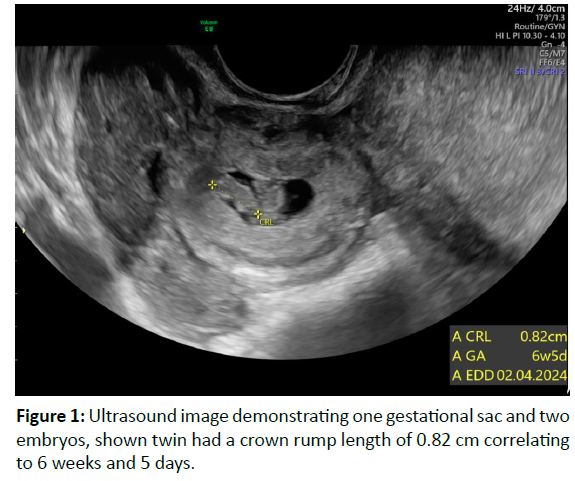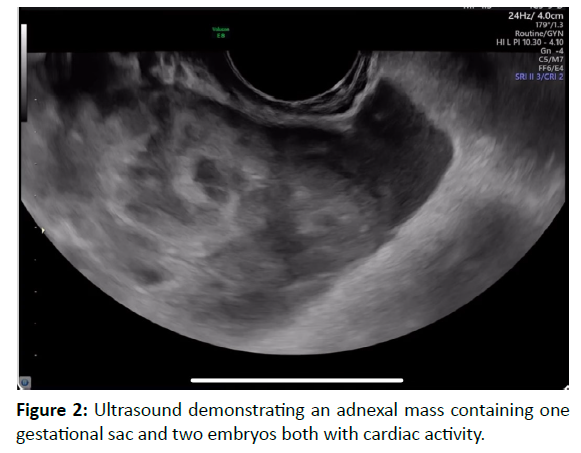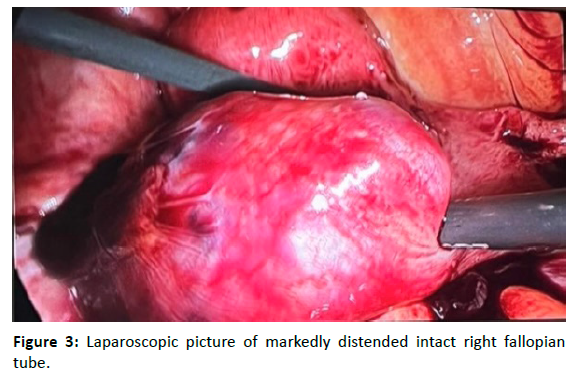Case Report - (2024) Volume 10, Issue 1
Unilateral Viable Twin Monochorionic Pregnancy: A Case Report
Viquar Qureshi* and
Ayah Hijazi
Department of Obstetrics and Gynecology, Women’s Health Hospital, King Abdulaziz Medical City, Riyadh, Saudi Arabia
*Correspondence:
Viquar Qureshi, Department of Obstetrics and Gynecology, Women’s Health Hospital, King Abdulaziz Medical City, Riyadh,
Saudi Arabia,
Email:
Received: 14-Jan-2024, Manuscript No. IPGOCR-24-18927;
Editor assigned: 16-Jan-2024, Pre QC No. IPGOCR-24-18927 (PQ);
Reviewed: 30-Jan-2024, QC No. IPGOCR-24-18927 (Q);
Revised: 05-Feb-2024, Manuscript No. IPGOCR-24-18927 (R);
Published:
15-Feb-2024, DOI: 10.36648/2471-8165.10.01.01
Abstract
An ectopic pregnancy occurs due to failure of migration of the fertilized ovum to the uterine cavity. Ectopic pregnancies are most commonly seen in the fallopian tube (about 94%), with 3% in the ovaries and the rest in the abdominal cavity, cervix or uterine cornua. Unilateral twin ectopic pregnancy is rare, occurring in 1 in 200 ectopic pregnancies and in 1 in 20,000 pregnancies. Only about 5-10% of ectopic pregnancies are live, and thus the incidence of a live tubal twin ectopic pregnancy is about 1 in 125,000 pregnancies.
Keywords
Ectopic; Fallopian tube; Unilateral twin ectopic; Live tubal twin ectopic
Introduction
An ectopic pregnancy occurs due to failure of migration of the fertilized ovum to the uterine cavity. Ectopic pregnancies are most commonly seen in the fallopian tube (about 94%), with 3% in the ovaries and the rest in the abdominal cavity, cervix or uterine cornua [1]. Unilateral twin ectopic pregnancy is rare, occurring in 1 in 200 ectopic pregnancies and in 1 in 20,000 pregnancies [2]. Only about 5-10% of ectopic pregnancies are live, and thus the incidence of a live tubal twin ectopic pregnancy is about 1 in 125,000 pregnancies [3].
Case Presentation
A 32-year-old woman presented to our emergency department complaining of a two day history of mild lower abdominal pain. She was in her fourth pregnancy, with her last three pregnancies ending in first trimester miscarriages. She was at her seventh week of gestation by last menstrual period. This pregnancy was induced by ovulation induction with the use of clomiphene citrate.
There were no associated sign and symptoms related to bowel and bladder and she had no history of vaginal bleeding. She was in a good general condition and her vital signs were normal. Bimanual examination revealed a bulky uterus and right adnexal fullness.
Her laboratory workup revealed a haemoglobin of 107 g/dl and beta human chorionic gonadotropin of 18,729 IU/L. A pelvic ultrasound revealed a heterogeneous endometrium with no intrauterine pregnancy; a right-sided tubal twin ectopic pregnancy was seen. There was one gestational sac with two viable embryos. One twin had a crown rump length correlating to 6 weeks and 5 days (Figure 1) of gestation, and the other twin correlating to 7 weeks, moderate amount of fluid in was seen in the pouch of Douglas (Figure 1 and Figure 2).

Figure 1: Ultrasound image demonstrating one gestational sac and two embryos, shown twin had a crown rump length of 0.82 cm correlating to 6 weeks and 5 days.

Figure 2: Ultrasound demonstrating an adnexal mass containing one gestational sac and two embryos both with cardiac activity.
A diagnosis of a right-sided tubal ectopic pregnancy was made, the patient was counseled about the diagnosis and management and agreed for a laparoscopic salpingectomy. At laparoscopy the uterus, both ovaries and left fallopian tube were normal. The right fallopian tube was intact but markedly distended along its length (Figure 3). About 150 ml of clotted blood was found in the peritoneal cavity. Right salpingectomy was done. Patient tolerated the procedure well and had an uneventful postoperative period.

Figure 3: Laparoscopic picture of markedly distended intact right fallopian tube.
Results and Discussion
The first case of unruptured twin tubal ectopic pregnancy was described in 1986 by Santos, et al. [4]. More than a 100 cases have been reported since then, however, this condition is highly underreported [1].
Pelvic inflammation, previous ectopic pregnancy, tubal surgery or ligation, congenital anomalies, and assisted reproductive technologies are all risk factors for ectopic pregnancy. Other risk factors, although less common, include increasing maternal age, smoking, use of intrauterine contraceptive devices, and defects in the zygote or the hormonal environment [2]. Ash, et al. proposed that the twin pregnancy's larger cell mass could slow down transport through a damaged tube, thus increase the risk of a twin tubal ectopic pregnancy [5].
Tubal rupture, hemoperitoneum, hemorrhagic shock, and maternal mortality can be caused by a delayed diagnosis [6]. The rupture rate of an ectopic pregnancy is reported to be about 32%, and this risk increases by approximately 2.5% every 24 hours when left untreated [7].
Goswami, et al. described a 6 cm right unruptured adnexal mass, containing a twin ectopic pregnancy. It has been speculated that tubal distension may not be the primary cause of tubal rupture. Although tubal distension is more in twin ectopic pregnancies due to the presence of two gestational sacs, trophoblastic invasion is probably less due to earlier gestational age of a twin tubal ectopic, compared with a singleton ectopic of the same gestational age [8,9].
Conclusion
As in our case the majority (95%) of twin ectopic pregnancies have been reported to be monozygotic. It's possible that many of these were actually dizygotic according to DNA analysis of twin ectopic pregnancy.
References
- Madaan S, Jaiswal A, Banode P, Dhok A, Dewani D. (2021) Spontaneous twin ectopic pregnancy managed successfully with methotrexate-mediated ultrasound-guided fetal reduction: A fertility-preserving approach. Cureus 13(8).
Google Scholar, Crossref, Indexed at
- Marta B, Patrizia V, Gianluca RD, Antonio P, Giuseppe T, et al. (2018) Unilateral twin tubal pregnancy: A case report and review of the literature. Acta Bio Medica: Atenei Parmensis, 89(3): 423.
Google Scholar, Crossref, Indexed at
- Parker J, Hewson AD, Calder‐Mason T, Lai J. (1999) Transvaginal ultrasound diagnosis of a live twin tubal ectopic pregnancy. Australas Radiol 43(1): 95-97.
Google Scholar, Crossref, Indexed at
- Santos CA, Sicuranza BS, Chatterjee MS. (1986) Twin tubal gestation diagnosed before rupture. Perinatol Neonatol 10: 52-3.
Google Scholar
- Ash KM, Lyons EA, Levi CS, Lindsay DJ. (1991) Endovaginal sonographic diagnosis of ectopic twin gestation. J Ultrasound Med 10(9): 497-500.
Google Scholar, Crossref, Indexed at
- Goswami D, Rathore AM, Batra S, Dubey C, Tyagi S, et al. (2013) Facility‐based review of 296 maternal deaths at a tertiary centre in India: Could they be prevented?. J Obstet Gynaecol Res 39(12): 1569-1579.
Google Scholar, Crossref, Indexed at
- Bickell NA, Bodian C, Anderson RM, Kase N. (2004) Time and the risk of ruptured tubal pregnancy. Obstet Gynecol 104(4): 789-794.
Google Scholar, Crossref, Indexed at
- Goswami D, Agrawal N, Arora V. (2015) Twin tubal pregnancy: A large unruptured ectopic pregnancy. J Obstet Gynaecol Res 41(11): 1820-1822.
Google Scholar, Crossref, Indexed at
- Neuman WL, Ponto K, Farber RA, Shangold GA. (1990) DNA analysis of unilateral twin ectopic gestation. Obstet Gynecol 75(3 Part 2): 479-483.
Google Scholar, Indexed at
Citation: Qureshi V. (2024) Unilateral Viable Twin Monochorionic Pregnancy: A Case Report. Gynecol Obstet Case Rep. Vol.10 No.1:01.
Copyright: © Qureshi V, et al. This is an open-access article distributed under the terms of the Creative Commons Attribution License, which permits unrestricted use, distribution, and reproduction in any medium, provided the original author and source are credited.




